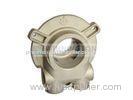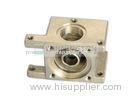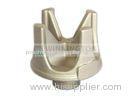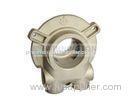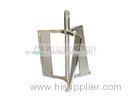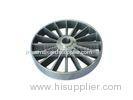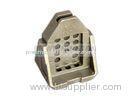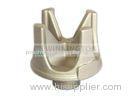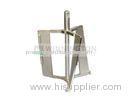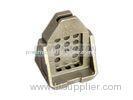|
Winnington Casting CO.,LTD
|
custom Precision Stainless steel casting lost wax process PED BS MIL
| Place of Origin: | Zhejiang, China (Mainland) |
|
|
|
| Add to My Favorites | |
| HiSupplier Escrow |
Product Detail
Stainless steel casting using lost wax process, foundry is PED certi
Stainless steel casting using lost wax process, foundry is PED certificated and with CNC machining in house.
Quick Detail:
- Stainless steel lost wax cast part of a valve component in marine industry;
- Material: 1.4517 stainless steel;
- Weight: 2.9kg; Cast weight range: 10g~80KG;
- Size:150x200x120mm;
- Chemical composition test operated by German spectrometer;
- X ray can be operated;
- Heat number tracing system;
Description:
Stainless steel casting using lost wax process for various industries such as Valves&pumps,Marine, oil, gas, medical, military, electronics. Min wall thickness 1.5mm, Raw casting tolerance according to VDG P690 (German standard);
Winnington casting is capable of a wide array of materials: stainless steel, carbon steel, duplex alloys, nickel-based materials, and more with different levels of complexity:
|
Stainless Steel (70%) |
Carbon Steel |
Alloy Steel |
|
17-4PH, CF3M (AISI 316L), CF8M (AISI 316), CF8 (AISI 304),CD4MCu, CD4MCuN,ANC20,1.4408,1.4517, 1.4306, 1.4581, 303, 430, 420, SCS1,SCS2 and more |
1020, SCS16, SCS14, SCS13, 1.0619, WCB, S355JR, 1045 , LCC and more |
4140, ANC2,CLA12C,42CrMo,8Q,6150 and more |
OVERVIEW OF LOST WAX CASTING PROCESS
Lost wax casting is regarded as a casting process to build near-net-shaped parts from almost any alloy. The most common use of lost wax casting has been the production preference of components requiring complex, especially thin-wall castings. Investment casting has for some time been perceived as a comparatively expensive process. But when compared to alternative processes which require extra welding or machining, an investment cast component can often dramatically reduce overall part production costs since it is made close to net shape.
The investment casting process begins with modeling of a sacrificial pattern with the basic geometrical shape as the finished cast part. Patterns are normally made of recyclable green wax that is injected into a metal wax injection die. Once a wax pattern is formed, it is assembled with other wax components to form a metal delivery system , called the gate and runner system. The entire wax assembly is then dipped in a ceramic slurry, covered with a sand stucco, and allowed to dry. The dipping and stuccoing process is repeated until a shell of ~6-8 mm is applied.
Once the ceramic has dried, the entire assembly is placed in a steam autoclave to remove most of the wax. After autoclaving, the remaining amount of wax that soaked into the ceramic shell is burned out in a furnace. At this point, all of the residual pattern and gating material is removed, and the ceramic mold remains. The mold is then preheated to a specific temperature and filled with molten metal, creating the metal casting. Once the casting has cooled sufficiently, the mold shell is chipped away from the casting. Next, the gates and runners are cut from the casting, and final postprocessing (shot blasting, machining, polishing) is done to finish the casting.
Applications:
Marine and Oil
Pumps
Valves
Pipe Fittings
Machinery
Power & Energy
Automotive
Mechanical Components
Specifications:
|
Casting weights |
20g~80kg |
|
Maximum Cast Size |
500*500*350mm |
|
Standards |
ASTM,JIS,DIN,BS,MIL |
|
Wall thickness |
1.5-2mm Min |
|
Casting process type |
Silica sol lost wax casting |
|
Machining |
CNC machining, CNC lathe |
|
Tolerances |
Raw casting material according to VDG P690. Can acheive tighter tolerance by CNC machining. |
|
NDT service |
Dye inspection, X ray inspection, ultrasonic inspection etc |
|
Surface finish service |
Electro polishing, satin polishing, hand polishing, pickled, zinc plating, vibration polishing; |
Competitive Advantage:


